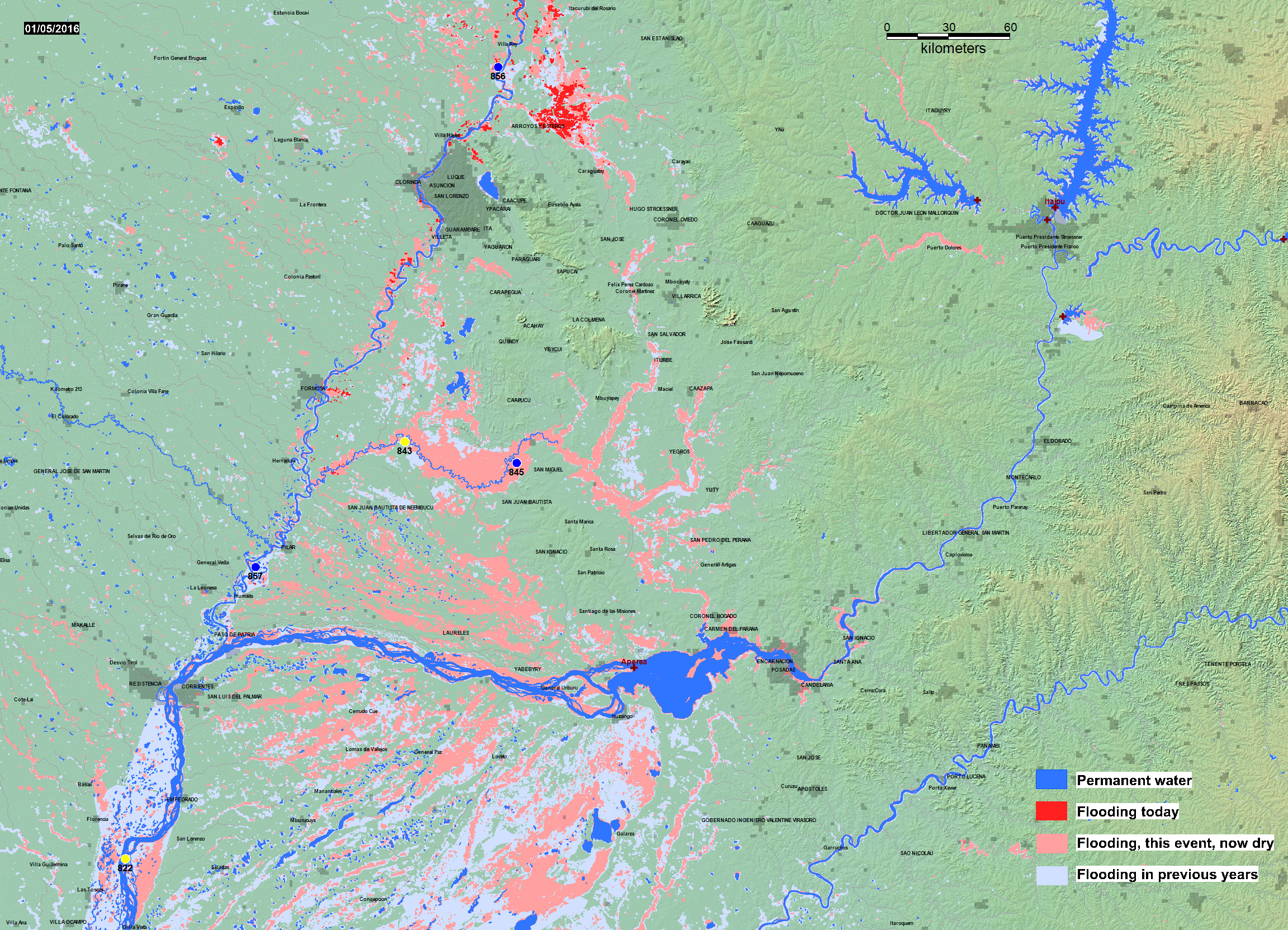



Four map products are available:
Note: The Observatory uses an automatically generated 14 day accumulation of the MODIS NRT daily water to show current conditions.Thus, "Flooding Today" on the maps refers to all flooding visible within the past two weeks on the date shown. This is necessary in order to provide complete geographic coverage under conditions of intermittent heavy cloud cover. The next daily update may show additional flooding if cloud cover permits, or such changes may be mapped after some days, when a break in cloud cover occurs.
This map may incorporate 250 m spatial resolution MODIS Rapid Response Subset data: provided by NASA's LANCE system: https://earthdata.nasa.gov/data/near-real-time-data/rapid-response/modis-subsets. It most commonly incorporates data from an automated MODIS 250 m flood processor using NASA LANCE data. See appropriate Surface Water Record display for more information, links to those component data, and technical description.We acknowledge the Land Atmosphere Near-real time Capability for EOS (LANCE) system operated by NASA/GSFC, and also the NASA Applications and Earth Sciences programs, which support development and improvements to the MODIS NRT flood processor.
When the automated processor is not detecting water due to sustained cloud cover, individual MODIS scenes and operator-assisted mapping can provide better results. This is because the automated processor relies on a filter using 3 day/6 image data sets to remove moving cloud shadow noise. The following method of water/land classification and map production from the Rapid Response subset data is effective: a) The subset geotiff data, bands 721 composites, are used. b) A band math/ratio and threshold approach is applied within Envi™ as follows: 1) Band math: "(float(b2) gt 200 ) or (((float(b1)+1)/(float(b2)+80)) gt .7) or float(b3) gt 17", where b2 = band 1; b3 = band 2; b1 = band 3 of the three channel RGB (bands 1,2,3) geotiff files. 3) This produces a binary geotif file with 0, black, as water, and 1, white, as land. 4) To remove cloud shadows ,if necessary, two images closely spaced in time (within one day) are processed, the classification results added, and the results added. Water must retain values of 0. 5) A GIS polygon (.shp format) is then fit around the water pixels within Envi™.
Landsat 8 data, when used, are provided by the United States Geological Survey Hazards Data Distribution System (http://hdds.usgs.gov/hdds2/). Landsat 8 is jointly managed by NASA and the United States Geological Survey.
Method of Landsat water/land classification and map production: 1) Landsat bands 3 (green), 0.53-0.59; 5 (near infrared), 085.-0.88; and 6, (short-wave infrared), 1.57-1.65, of the Operational Land Imager (OLI) sensor are used to produce a color composite for quality control purposes. 2) The following processing steps are performed to produce classified water pixels: a) Using Envi™, an NDVI-like product is produced: band 3-band 5/band 3 + band 5. b) Water pixels are identified via a threshold: "water" = < -.04 of this ratio result, c) GIS (.shp files) are then produced within Envi™ and outline the preliminary water areas. d). Within GIS software, the polygons are displayed over the tif image, and evident cloud shadow-sourced and other error polygons are manually deleted. This method is designed for rapid, operator-assisted transformation of Landsat image data into water map information. The band 3/ band 5 information when processed in this way avoids most cloud shadow (false positives) and provides sensitive water/land discrimination.
At selected locations, a time series of satellite microwave-based daily river discharge measurements are available. These define the estimated recurrence interval of mapped flooding. Click on the colored dots in the online Current Conditions display. Yellow dots: low flow (<50 % mean daily runoff for this date); Blue dots: normal flow; Purple dots: moderate flooding (>1.33 yr recurrence); Red, major flooding (> 5 yr recurrence). See River Watch Global Display for more information.
The River Watch output (representative display below, for site #856) indicates that at this location the flood exceeded the computed 30 yr recurrence interval event (period of record is 1998 to present). This year's flooding has been very severe (2, on a three-fold, 1, 1.5, and 2 scale). The Flood Observatory assigned a preliminary magnitude of 6.9 to this event, and as based on its severity, area affected, and duration. Flooding is still underway and the archived magnitude value will be somewhat higher.

Maps from other organizations (if available from DFO)
Brakenridge, G.R., Slayback, D., Kettner, A.J., Policelli, F., De Groeve, T., and Cohen, S., 2014, Rapid Response Mapping of the 2014 Flooding in Paraguay and Southern Brazil, DFO Event # 4150, Current Conditions and Maximum Flood Extent, http://floodobservatory.colorado.edu/Version3/2014Paraguay4150.html.
Maps and associated data generated at DFO are available for public use and licensed under a Creative Commons Attribution 3.0 Unported License. Work supported by the NASA Applications Program (Dr. Francis Lindsay) and CAF - banco de desarrollo de América Latina, The Development Bank for Latin America (Mr. Eric Van Praag) in collaboration with GeoSUR.
